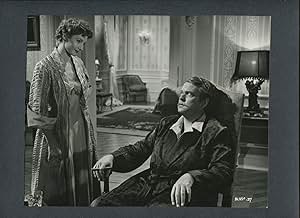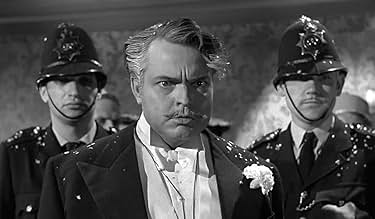NOTE IMDb
6,5/10
1,2 k
MA NOTE
Ajouter une intrigue dans votre langueA trilogy of fantastic stories involving murder and the supernatural.A trilogy of fantastic stories involving murder and the supernatural.A trilogy of fantastic stories involving murder and the supernatural.
André Morell
- Dr. Audlin (segment "Lord Mountdrago")
- (as Andre Morell)
Leueen MacGrath
- Woman in the House (segment "In the Picture")
- (as Leueen Mac Grath)
Frances Baker
- Woman in Club Dream
- (non crédité)
Robin Burns
- Member of Parliament
- (non crédité)
Avis à la une
I was first introduced to this film in a British Cinema class I took at the College of Santa Fe and it's haunted me ever since! Despite what the box claims, Orson Wells has a small part in the and of the film... but the real star is Alan Badel. The first segment, "In the Picture," deals with a museum attendant who's paintings have a real, and sinister, life of their own. The second segment, "You Killed Elizabeth," is not supernatural, and probably the film's dullest installment, but has some good character to it. The final segment, which shows Badel at his absolute evilest, "Lord Mountdrago," has Wells and Badel as political adversaries, and Wells' murderous dreams become real. Of all the small obscure murder mystery / horror gems to go unnoticed from Britain this is certainly the one I wish would receive more attention. It is chilling (my favorite segment remains "In the Picture"), well acted, and brilliantly scripted. Rent it if you find it at your video store! Watch it if it (miraculously) appears on television! Or simply go out and buy it (you won't regret it!). If you want to see the BEST horror anthology film ever, look no further than THREE CASES OF MURDER.
This trilogy of supernatural murders is interesting but not essential. Everybody is ok to say that the first segment is the best with that story of alive painting, really creepy. The second segment is the less interesting, story of two men competiting for the same woman, one of them having black holes (kind of William Irish story). And the last one is the most overlooked thanks to Orson Welles in this nightmare comedy story, it seems it is directed by Welles himself. Alan Badel is the threatening link between these three segments. Not a masterpiece but entertaining.
I love the way Eamonn Andrews, in his introduction, saunters over to the mantelshelf, picks up the cigarettes and lights one! How better to make him seem to be acting naturally in the 50s?
Story 1 is intriguing and disturbing but a bit too long. Some of the flat spots add to the suspense and atmosphere, but some are just flat spots.
Agatha Christie has spoiled us for the likes of Story 2. I'm sure most people see the twist coming a mile off. The only sub-standard section.
A great actor and a master storyteller come together to produce something special in Story 3, marginally better than Story 1 and thus best of the bunch.
Story 1 is intriguing and disturbing but a bit too long. Some of the flat spots add to the suspense and atmosphere, but some are just flat spots.
Agatha Christie has spoiled us for the likes of Story 2. I'm sure most people see the twist coming a mile off. The only sub-standard section.
A great actor and a master storyteller come together to produce something special in Story 3, marginally better than Story 1 and thus best of the bunch.
Three stories of murder and the supernatural. In the first, a museum worker is introduced to a world behind the pictures he sees every day. Second, when two lifelong friends fall in love with the same woman and she is killed, they are obvious suspects. Is their friendship strong enough for them to alibi each other? Third, when a young politician is terribly hurt by the arrogant Secretary for Foreign Affairs Lord Mountdrago, he uses Mountdrago's dreams to get revenge.
Orson Welles received top billing, but he appears only in "Lord Mountdrago." According to Patrick Macnee, who had a supporting role, Welles began making suggestions to director George More O'Ferrall throughout the first day of filming, and by the third day he had taken over the direction of the entire segment.
Does this surprise anyone? Of course Welles would be the star to draw audiences in, and of course he would try to take over the production, because that was very much the sort of chap he was. For better or worse, a film starring Welles was very much a Welles film.
As far as anthologies go, this one is not often remembered. And as far as horror anthologies go (if this even counts), it seems all but forgotten, overshadowed by the later Amicus films. I love Amicus, and it is hard to beat them, but surely this film must have been some influence on the later Amicus and Hammer productions.
Orson Welles received top billing, but he appears only in "Lord Mountdrago." According to Patrick Macnee, who had a supporting role, Welles began making suggestions to director George More O'Ferrall throughout the first day of filming, and by the third day he had taken over the direction of the entire segment.
Does this surprise anyone? Of course Welles would be the star to draw audiences in, and of course he would try to take over the production, because that was very much the sort of chap he was. For better or worse, a film starring Welles was very much a Welles film.
As far as anthologies go, this one is not often remembered. And as far as horror anthologies go (if this even counts), it seems all but forgotten, overshadowed by the later Amicus films. I love Amicus, and it is hard to beat them, but surely this film must have been some influence on the later Amicus and Hammer productions.
British anthology from the 1950's when the world was black and white, smoking was considered healthy & most people spoke with a plum in their mouths. Eamonn Andrews introduces three stories. The first is about a mysterious painting in an art gallery, the second a love triangle and the third a deadly tale of two political enemies. The first & third feature the supernatural. Each riveting story features a different director but they are all of a high calibre. I think it would have been slightly better had the second story also featured the supernatural, but only a minor quibble.
As a film fan of over 35 years I only discovered this gem when it was screened on British TV two days ago. Superb.
Le saviez-vous
- AnecdotesAccording to cast member Patrick Macnee, the "Lord Mountdrago" segment was mostly directed by star Orson Welles. This claim is supported by the abundance of high-angle, wide-angle and deep focus shots Welles was known for.
- Citations
George Wheeler ("You Killed Elizabeth" segment): How was Manchester?
Edgar Curtain ("You Killed Elizabeth" segment): Wet, in every sense of the word. Those boys can really throw a party.
- Versions alternativesThere is an Italian edition of this film on DVD, distributed by DNA srl, "GHOST STORY (Four Men on a Raft, 1941 + Return to Glennascaul, 1951) + TRE CASI DI ASSASSINIO (3 casi di omicidio, 1954)" (2 Films on a single DVD), re-edited with the contribution of film historian Riccardo Cusin. This version is also available for streaming on some platforms.
- ConnexionsFeatured in Visions: Two Directors: Wendy Toye and Sally Potter (1984)
Meilleurs choix
Connectez-vous pour évaluer et suivre la liste de favoris afin de recevoir des recommandations personnalisées
- How long is Three Cases of Murder?Alimenté par Alexa
Détails
- Date de sortie
- Pays d’origine
- Langue
- Aussi connu sous le nom de
- Three Cases of Murder
- Lieux de tournage
- Sociétés de production
- Voir plus de crédits d'entreprise sur IMDbPro
Box-office
- Budget
- 250 000 £GB (estimé)
- Durée1 heure 39 minutes
- Couleur
Contribuer à cette page
Suggérer une modification ou ajouter du contenu manquant

Lacune principale
By what name was Trois meurtres (1954) officially released in India in English?
Répondre



























